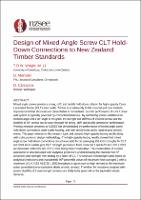| dc.description.abstract | Mixed angle screws provide a strong, stiff, and ductile hold-down solution for high-capacity Cross Laminated Timber (CLT) shear walls. Timber is an inherently brittle material and most inelastic responses in timber structures are concentrated in connections. Seismic performance of a CLT shear wall system is typically governed by connection behaviour. By combining screws installed at an inclined angle and a 90° angle to the grain, the strength and stiffness of inclined screws and the ductility of 90° screws can be superimposed for strong, stiff, and ductile connection performance. Previous research presented to NZSEE has demonstrated the performance of mixed angle screw hold-down connections under cyclic loading, and their ability to be easily repaired post seismic events. This paper extends on this research topic and presents high-capacity testing results along with a discussion on design methodology. The high-capacity testing results showed that mixed angle screw hold-down connections can achieve yield forces averaging 952 kN in Douglas fir CLT and 1029 kN in radiata pine CLT. Strength predictions from Eurocode 5 and NZS AS 1720.1:2022 are discussed, with NZS AS 1720.1:2022 being more conservative. The conservatism of current approaches is also discussed with analytical predictions underestimating the characteristic 5th percentile yield strength from testing by a factor of 1.3. The observed overstrength factor based on analytical predictions and characteristic 95th percentile values of maximum force averaged 2 with a maximum of 2.4. NZS AS1720.1:2022 introduces a cap on overstrength demand at the maximum action generated due to equivalent elastic seismic demand. Therefore, for structures designed with system ductility of 2 overstrength demands are likely to be governed by the equivalent elastic demands. | |

